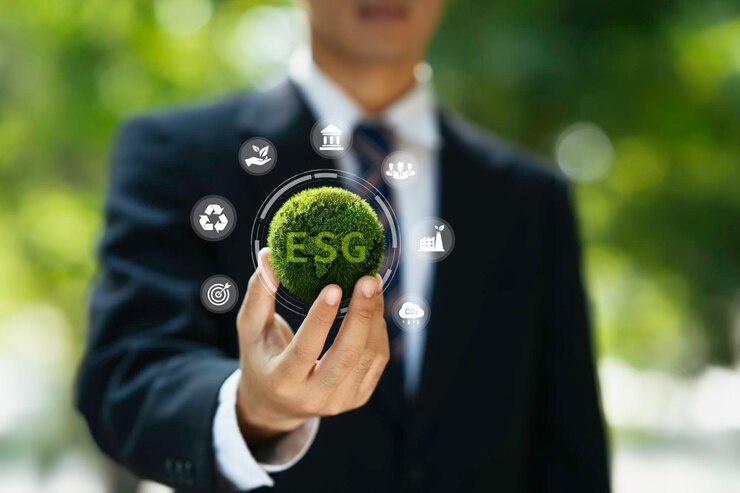Across the globe, businesses are increasingly focusing on environmental, social, and governance ESG considerations to drive sustainability reports and compliance in their business operations. This aligns with investor regulator and stakeholder expectations which are now making businesses revisit their overall strategy. In such a scenario having an ESG certification tangibly improves a company’s commitment to ESG goals. It makes it appear not only more attractive in the eyes of various stakeholders but also speaks about the responsibility and governance standards. Whilst ESG certifications are important tools in an organization’s ESG journey the process of obtaining such certifications can often be complex and requires to be well thought out and executed. Below are some key pointers to remember before choosing the appropriate ESG certification and embarking on the ESG certification journey.
What is ESG Certification?
As with any other certification ESG certification accords a formal recognition of a business’ commitment, strategy processes, standards, and systems towards environment sustainability, social responsibility, and governance. It provides an outside validation of how robust the company’s operations are in reaching the desired ESG goals. The process of ESG certification not only streamlines the company’s overall processes but also puts in place checks and balances, engineered processes, and technical systems that allow a company to be compliant and deliver on its ESG promise. Obtaining an ESG certification works wonders for a company’s reputation an significantly improves its brand image, investor positioning, and stakeholder trust.
Key Steps to Achieve ESG Certification
- The first step to achieving an ESG certification is to do a detailed evaluation of the different ESG frameworks to understand which one works best for a particular business. This includes having a clear understanding of the business’s overall strategy, sectoral experience, long-term vision and existing strengths and weaknesses. Being able to align the appropriate ESG certification framework ensures that the underlying criteria and evaluation processes are the right fit for a particular business. For instance, the B Corp Certification focuses on an organization’s social and environmental performance. On the other hand, ISO 14001 focuses more on environmental management systems while GRESB is designed keeping in mind specific sectors such as real estate and infrastructure. As such the first step of the ESG certification journey begins with understanding the business, evaluating the appropriate certification framework mapping the application process, the documentation requirements, and the scoring criteria to clearly and objectively determine the best ESG certification.
- After choosing the best ESG certification framework the organization must conduct an in-depth current state analysis of its ESG performance. In particular, it must do an as-is study of the existing business processes policies in terms of the environmental, social, and governance issues, an assessment of the existing data and systems, and finally an analysis of its existing resources including human capital and available budgets. This in-depth current state analysis will help the organization understand its current maturity and thereby identify gaps between the as-is state and the required state under the chosen ESG certification framework. In addition, this analysis will also help the organization gather some baseline information on key performance indicators (KPIs) which may include parameters such as carbon emissions, social inclusion, and gender diversity.
- The next step is to develop a tailor-made ESG strategy that will help the organization transition from its current state to the desired state which will comply with the relevant ESG certification framework. The strategy should include specific goals, projects, resources, and timelines to achieve the same. It should also have actionable strategies that are aligned with each of the key ESG pillars of environment, social and governance. For example, the ESG strategy could focus on energy efficiency, waste management workplace policies, risk management ethical governance practices, and management oversight. Managers within the organization should ensure that adequate stakeholders are mobilized to deliver alignment between the business vision and the ESG strategy.
- Implement ESG practices and track progress – as with any important certification, the key to ESG certification is the execution of the adopted ESG strategies. This includes setting up an appropriate project management office, rolling out required programs modeling different policies and processes, and setting up monitoring mechanisms to ensure that the adopted projects are delivered as per expectations. To ensure that the projects are executed within planned timelines and cost the organization must set up strong data collection processes and systems which will help the management track performance in real-time against the defined ESG goals and project metrics. This will also help provide fact-based evidence at the time of the actual ESG certification to ensure that the required criteria are appropriately addressed.
- To achieve the best ESG certification it is often critical to ensure seamless collaboration among stakeholders both internal and external. For instance, making the employees aware and driving a culture of ESG consciousness among the suppliers, customers and channel partners will help create an overworking sense of collaboration. This goes a long way in ensuring that the communication among the different partners is uniform and there is active involvement from all stakeholders in achieving the required ESG criteria. This can also ensure that any initiative by an organization’s management is met with cooperation and is driven to success through seamless information exchange.
- Once the organization has achieved its chosen ESG compliance criteria often an external audit conducted by accredited auditors will help the organization obtain its desired ESG certification this process usually includes the submission of a formal request along with the documentation that is required to be shown as evidence of the ESG performance, participating in physical assessments and interviews, noting the audit findings, and addressing opportunities of improvement if any. At the close of the audit process, once the observations are successfully addressed, the assessor usually provides the desired ESG certification to the organization.
- Once the certification is received from the assessor, this can be published across the company’s marketing channels which include its public relations office, brand building, and investor relations teams. The ESG certification will help to elevate the company’s overall reputation and provide a mark of approval in reinforcing the company’s performance as far as environmental social and governance practices are concerned. Often this has a ripple effect of positive investor behaviour regulator commendation and overall market goodwill.
Maintaining and Improving ESG Practices
Whilst it may appear that achieving the desired ESG certification for businesses is the end goal when it is the start of an altogether different journey. The ESG certificate programs include a journey of continuous internal monitoring and improvement to further strengthen sustainability Goals. This can often be done through the following steps:
- Continuous monitoring and sustainability reporting through the newly established systems to monitor ESG performance against the preset KPIs goes a long way in ensuring robust performance. Additionally, frameworks such as GRI or SSB can be adopted for standardized reporting. These frameworks also drive the overall information disclosure which helps maintain credibility and trust among the shareholders.
- Management of ESG-certified organizations is often found to be updated on the constantly evolving standards and guidelines. This helps them keep a steady view of what’s happening in the industry and incorporate best practices as required from time to time.
- At regular intervals of time, organizations also invest in recertification processes that maintain overall compliance and identify newer areas of improvement that elevate the company’s overall operations and performance.
- The ESG certification journey also infuses new technology within an organization to enhance ESG outcomes. For example, newer energy management systems may be used to better manage carbon emissions, new age technologies such as artificial intelligence may be used to optimize overall spending and supply chain performance, and many more such use cases start to appear along the journey.
- The biggest outcome of this entire ESG certification process is the culture of sustainability that is built into the organization thereby raising the awareness levels of various stakeholders and creating a positive loop to constantly deliver on ESG goals and further optimize operations.
Conclusion
ESG certifications are great enablers for a business that wants to align its operations concerning global sustainability social and governance goals. This helps the company establish itself as a strong player on the global map which further enhances its reputation, improves overall operations and elevates its overall image in the eyes of its investors and other stakeholders. Choosing the most appropriate ESG framework creates a culture of compliance and delivers a continuous improvement culture which not only optimizes the business operations on an ongoing basis but also reinforces the management’s commitment towards sustainability and the promise of a better tomorrow.
FAQ
How much does ESG certification cost?
The actual certification cost varies depending on the certification framework, size, scope, coverage, and maturity of the business. It could vary from anywhere between $10k to $200k depending on the compliance needs.
How long does it take to achieve ESG certification?
The timeline also varies between 6 months to 1-2 years depending on the certification framework, the complexity of the business, and the maturity of its current state operations.
What data is typically required for ESG certification?
The data requirements usually comprise environmental parameters (e.g., emissions), social practices (e.g., diversity), and governance policies (e.g., board structure).







